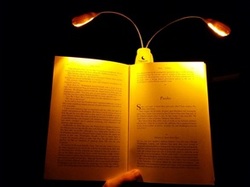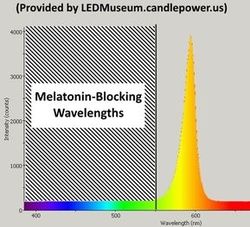Fall Asleep Faster...With Amber Light
"Exposure to excessive light at night, including extended use of various electronic media, can disrupt sleep or exacerbate sleep disorders, especially in children and adolescents. This effect can be minimized by using dim, [warm] lighting in the nighttime bedroom environment."
–Recommendation from the American Medical Association, 2012.
–Recommendation from the American Medical Association, 2012.
How Does Amber Light Improve Sleep?
As numerous studies indicate, modern light sources (particularly fluorescent lights, laptops, and cellphone screens) contain a high level of blue light that disrupts melatonin production and throws off our natural circadian rhythms—keeping us awake when we should be sleeping. Many sleep specialists suggest that this widespread exposure to blue light, long after the sun has set, is a major contributor to the modern epidemic of insomnia.
However, the amber-spectrum light emitted by firelight and candlelight demonstrates no negative effect on melatonin production. SomniLight amber sleep lamps and amber book lights are specially designed to mimic the amber-wavelength light of candlelight without sacrificing the safety and convenience of modern lighting, allowing you to fall asleep up to an hour faster.
However, the amber-spectrum light emitted by firelight and candlelight demonstrates no negative effect on melatonin production. SomniLight amber sleep lamps and amber book lights are specially designed to mimic the amber-wavelength light of candlelight without sacrificing the safety and convenience of modern lighting, allowing you to fall asleep up to an hour faster.
When using amber light is impractical (late night shift work, gaming, or computer use), amber glasses have been proven to block up to 99% of blue wavelengths, preserving your body's natural levels of melatonin. Our lights and lenses allow you to enjoy your evening—reading, writing, and relaxing—without the corresponding disruption in melatonin production caused by traditional light sources. In addition to potential sleep benefits, numerous studies suggest that a natural balance of serotonin and melatonin can result in a wide array of mood and health benefits.
Finally, the same blue wavelengths that cause insomnia have also been proven to trigger eye strain, photophobia, and migraines. Multiple independent studies have demonstrated that red migraine glasses can reduce the occurrence of chronic migraines by up to 74% and alleviate migraine pain in as little as 10 seconds.
Finally, the same blue wavelengths that cause insomnia have also been proven to trigger eye strain, photophobia, and migraines. Multiple independent studies have demonstrated that red migraine glasses can reduce the occurrence of chronic migraines by up to 74% and alleviate migraine pain in as little as 10 seconds.
Read reviews of SomniLight Amber Book Lights, Amber Glasses, and Migraine Glasses here.
Read the latest research about Blue Light and Insomnia, Night Shift Disorder, Red Migraine Glasses, Melatonin and Cancer, ADHD Insomnia, Low-blue Nursery Lamps, and Red lenses for cone disorders.
Purchase our Amber Book Lights, Amber Sleep Lamps, Amber Nursery Lamps, Red Night Lights, Amber Sleep Glasses, FL-41 Glasses, and Photophobia Glasses here.
Read the latest research about Blue Light and Insomnia, Night Shift Disorder, Red Migraine Glasses, Melatonin and Cancer, ADHD Insomnia, Low-blue Nursery Lamps, and Red lenses for cone disorders.
Purchase our Amber Book Lights, Amber Sleep Lamps, Amber Nursery Lamps, Red Night Lights, Amber Sleep Glasses, FL-41 Glasses, and Photophobia Glasses here.

